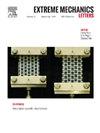On failure mechanisms and load-parallel cracking in confined elastomeric layers
IF 4.5
3区 工程技术
Q2 MATERIALS SCIENCE, MULTIDISCIPLINARY
引用次数: 0
Abstract
Thin layers of elastomers bonded to two rigid plates demonstrate unusual failure response. Historically, it has been believed that strongly-bonded layers fail by two distinct mechanisms: (i) internal/external penny-shaped crack nucleation and propagation, and (ii) cavitation, that is, cavity growth leading to fibrillation and then failure. However, recent work has demonstrated that cavitation itself is predominantly a fracture process. While the equations describing cavitation from a macroscopic or top-down view are now known and validated with experiments, several aspects of the cavitation crack growth need to be better understood. Notably, cavitation often involves through-thickness crack growth parallel to the loading direction, raising questions about when it initiates instead of the more typical penny-shaped cracks perpendicular to the load. Understanding and controlling the two vertical and horizontal crack growth is key to developing tougher soft films and adhesives. The purpose of this Letter is to provide an explanation for the load-parallel crack growth through a comprehensive numerical analysis and highlight the role of various material and geometrical parameters.
承压弹性体层破坏机制及荷载平行开裂研究
粘接在两个刚性板上的薄层弹性体表现出不同寻常的失效响应。从历史上看,人们一直认为强粘结层的失效有两种不同的机制:(i)内部/外部便士形裂纹的形核和扩展,以及(ii)空化,即空腔的生长导致纤颤然后失效。然而,最近的研究表明,空化本身主要是一个破裂过程。虽然从宏观或自上而下的角度描述空化的方程现在已知并通过实验验证,但空化裂纹扩展的几个方面需要更好地理解。值得注意的是,空化通常涉及平行于加载方向的贯穿厚度裂纹扩展,这引起了关于何时开始的问题,而不是更典型的垂直于加载的便士形裂纹。了解和控制两种垂直和水平裂纹的扩展是开发更坚韧的软膜和胶粘剂的关键。这封信的目的是通过全面的数值分析来解释荷载平行裂纹扩展,并突出各种材料和几何参数的作用。
本文章由计算机程序翻译,如有差异,请以英文原文为准。
求助全文
约1分钟内获得全文
求助全文
来源期刊

Extreme Mechanics Letters
Engineering-Mechanics of Materials
CiteScore
9.20
自引率
4.30%
发文量
179
审稿时长
45 days
期刊介绍:
Extreme Mechanics Letters (EML) enables rapid communication of research that highlights the role of mechanics in multi-disciplinary areas across materials science, physics, chemistry, biology, medicine and engineering. Emphasis is on the impact, depth and originality of new concepts, methods and observations at the forefront of applied sciences.
 求助内容:
求助内容: 应助结果提醒方式:
应助结果提醒方式:


